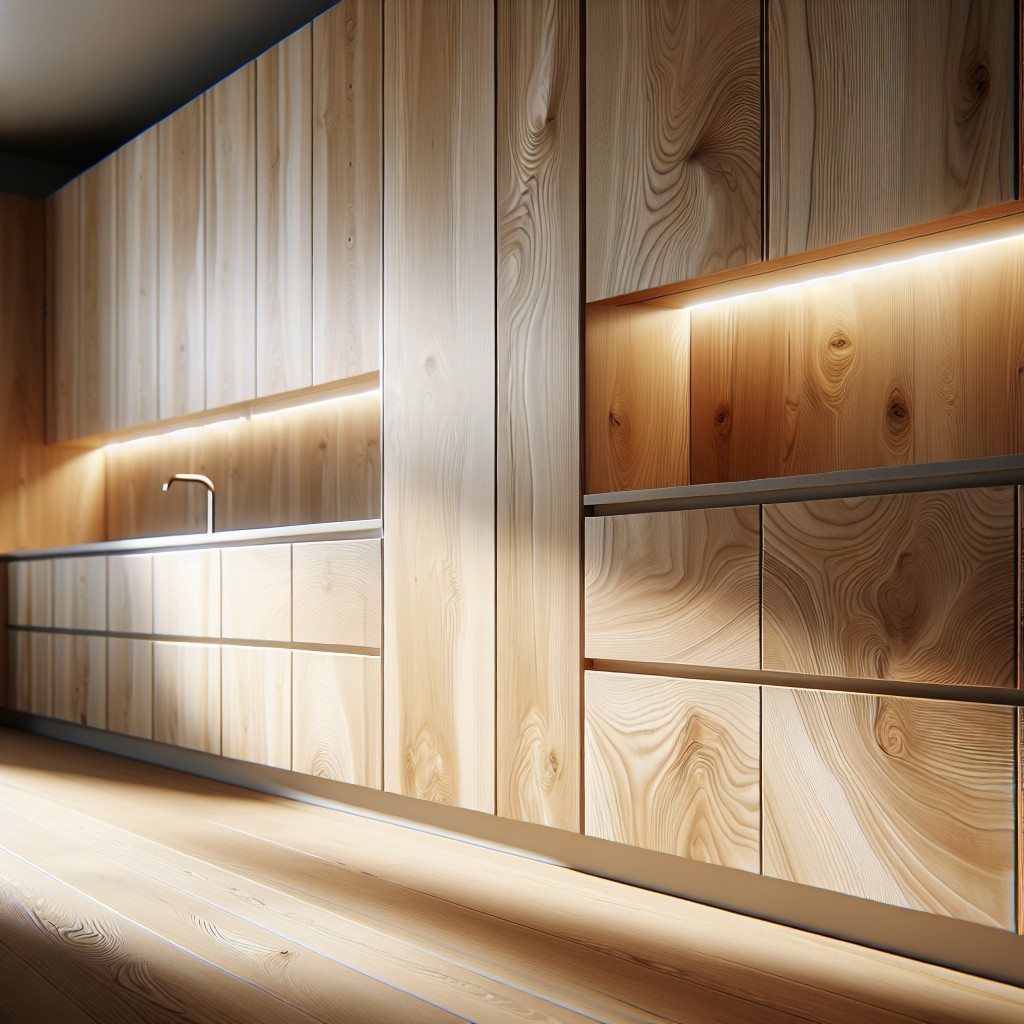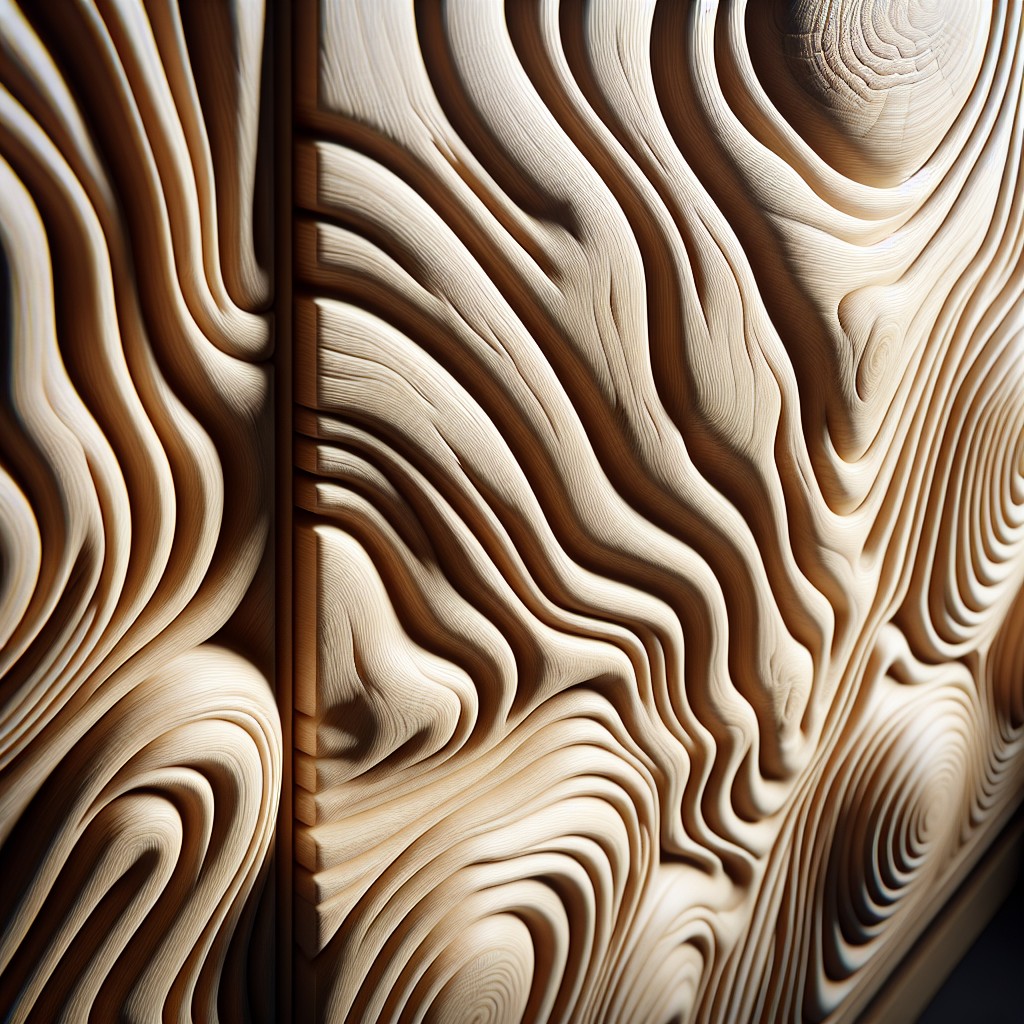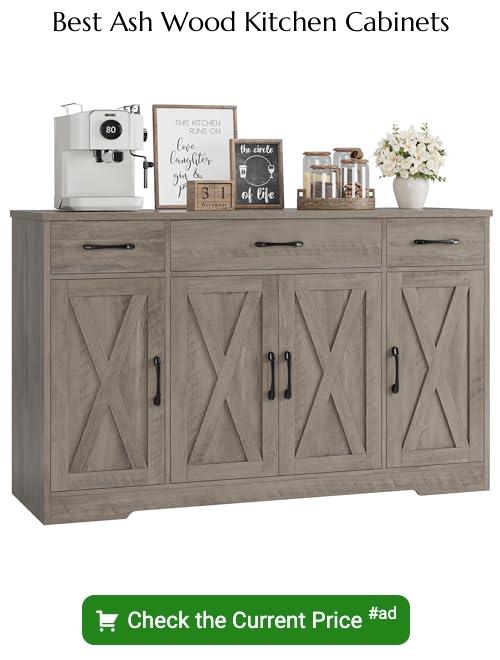Last updated on
Ash wood cabinets have become an increasingly popular choice for modern kitchens because of their versatility, beauty, and durability which we will explore in detail in this comprehensive guide.
Key takeaways:
- Ash wood cabinets are versatile, beautiful, and durable.
- Ash cabinets have a straight grain pattern and come in light color tones.
- Ash cabinets are known for their durability and flexibility in design.
- Ash wood is a sustainable option for cabinetry.
- Ash cabinets can be personalized with stains and finishes to fit any aesthetic.
What's Inside
Pros of Ash Cabinets

Ash wood boasts a straight grain pattern that exudes a contemporary vibe. Its light color tones, ranging from cream to light brown, provide a neutral backdrop suitable for a variety of kitchen designs.
Known for its impressive durability, ash handles the rigors of a bustling kitchen environment with ease, resisting dents and scratches more effectively than softer woods.
The material’s flexibility is another notable asset, allowing for intricate designs without compromising on strength.
Environmentally conscious homeowners will appreciate that ash trees, especially from responsible sources, offer a sustainable option for cabinetry due to their abundant availability and rapid growth rate.
Additionally, ash wood’s ability to accept stains and finishes well means you can personalize cabinets to your taste, ensuring they fit seamlessly into your envisioned kitchen aesthetic.
Cons of Ash Cabinets

While ash wood’s striking grain pattern is often celebrated, it’s worth noting that for some, this distinctiveness might be too bold, potentially overshadowing other design elements in your space.
Additionally, ash is a lighter-colored wood, meaning it may not suit those who prefer the rich, dark hues that woods like walnut or mahogany offer.
In terms of cost, ash is typically more expensive than some common hardwood alternatives such as pine or maple.
Its price point can also be a stretch for those on a tighter budget.
Furthermore, if your heart is set on ash, consider its availability; it’s less commonly found than oak or birch, possibly leading to longer wait times for your cabinets to arrive or be completed.
Despite its durability, ash is still susceptible to scratches and dents, which could be a concern in bustling, high-traffic kitchen environments.
Owners need to be vigilant about maintenance to keep the cabinets looking pristine over time.
Lastly, as ash tends to take on a yellowish hue with age, it may not be the best choice for those who prefer a wood that maintains its original color over long periods.
This natural aging process might not align seamlessly with every kitchen’s evolving design aesthetic.
Types of Ash Wood Cabinets
White ash cabinets are prized for their light tones and straight grain, creating a contemporary look.
Black ash, with its darker hues, offers a more traditional or rustic charm, suitable for a variety of design aesthetics.
Ash veneer cabinets provide a cost-effective alternative, furnishing the allure of ash at a lower price point.
For the eco-conscious, reclaimed ash from old structures is a sustainable choice, adding unique character and history to your space.
Each variant carries the intrinsic qualities of ash wood while offering distinct visual and textural differences, enabling personalization according to taste and decor.
White Ash Cabinets
Characterized by their light color and smooth grain, cabinets made from white ash create an airy and inviting atmosphere in any kitchen. Their naturally pale tones provide a neutral backdrop, allowing for versatility in decor and color schemes. The wood’s strength and elasticity, often compared to oak, make it an excellent choice for detailed joinery and intricate designs, suitable for both modern and traditional styles.
To amplify the beauty of white ash, consider pairing it with subtle stain that enhances its grain without overshadowing its understated elegance. Thanks to its light color, this type of cabinet can also help small kitchens appear larger by reflecting more light.
Additionally, white ash adapts well to various finishes and can be easily refinished, should design trends or personal tastes change over time. This adaptability makes it not only a stylish but also a practical option for the ever-evolving home.
Black Ash Cabinets
Distinguished by their naturally darker tone, black ash cabinets offer a rich aesthetic that can anchor a room’s design. Known for its straight grain and uniform texture, black ash lends itself well to contemporary and traditional kitchens alike.
When opting for this type of cabinetry, consider the following:
- Lighting: Since the wood is darker, adequate lighting is crucial to prevent the space from feeling too somber.
- Complementing Colors: To balance the darkness, pair with lighter countertops or backsplashes.
- Maintenance: Darker cabinets may show dust and fingerprints more readily, so regular cleaning is essential.
- Durability: Like its lighter counterpart, black ash is hard and resilient, ensuring longevity in a busy kitchen.
- Finish Options: Emphasize the natural beauty of black ash with a clear coat or use stains to deepen the hue.
Ash Veneer Cabinets
Choosing ash veneer cabinets offers a practical alternative to solid wood while preserving the aesthetic appeal. Veneer refers to thin slices of ash glued onto core panels, which can be made of various materials, including plywood, particleboard, or MDF. These panels are then used to construct the cabinetry.
Here’s how veneer cabinets stand out:
- Cost-Effectiveness: They’re significantly more affordable than solid ash counterparts, providing a similar look without the hefty price tag.
- Consistency: The use of veneer ensures uniformity in grain and color, granting your kitchen a cohesive appearance.
- Resource Efficiency: Veneers maximize the yield from a single ash tree, making them an environmentally friendly option.
- Versatility: Ash veneer cabinets can be treated with a range of finishes, from stains to paints, allowing for a custom look.
Importantly, the quality of veneer cabinets can vary. Higher-quality options use thicker veneer layers and robust core materials, ensuring longevity and resistance to warping or peeling. When considering ash veneer cabinets, it’s essential to evaluate the quality of both veneer and core materials for best results.
Reclaimed Ash Cabinets
Reclaimed ash wood brings history, character, and a sustainable aspect to kitchen cabinetry. Sourced from old structures, this aged timber offers an eco-friendly option for those looking to reduce their environmental impact. The wood often exhibits a unique patina and signs of its past life, such as nail holes or weathering, adding to its rustic charm.
Reclaimed ash is also known for its strength and durability, having stood the test of time. When opting for this type of cabinetry, you’re not just choosing a stylish kitchen feature – you’re also contributing to the conservation of forests by reusing existing materials.
As each piece is unique, it allows for a highly personalized kitchen infused with a sense of history and natural beauty.
Finishes for Ash Cabinets
Selecting the right finish can protect your ash wood cabinets and enhance their natural grain. A clear lacquer or varnish finish showcases the wood’s authentic beauty, making the intricate patterns stand out.
For a more contemporary style, consider a matte or satin finish; these options minimize reflections and give the cabinets a sleek, modern look.
Staining is another route that can alter the hue of the wood to fit your aesthetic preferences, from light pastels to deep, rich tones.
For those desiring eco-friendly options, natural oil finishes, such as linseed or tung oil, provide a non-toxic alternative that nourishes the wood and offers a subtle, warm glow.
Remember, the right finish not only affects appearance but also plays a crucial role in the longevity of your cabinets, safeguarding them from moisture and everyday wear and tear.
Caring for Ash Cabinets
To maintain the natural beauty and functionality of ash wood cabinets, regular care is essential. Here’s a straightforward guide to keep them in top condition:
1. Daily Dusting: Wipe down the cabinet surfaces with a soft, dry cloth. Dust can be abrasive and, over time, may dull the finish if not removed regularly.
2. Prompt Spill Cleaning: Address spills immediately using a slightly damp cloth and then dry the area thoroughly. Liquids left on wood can cause staining or warping.
3. Use Gentle Cleaners: Opt for mild dish soap diluted in water for more thorough cleaning. Harsh chemicals can strip the finish and damage the wood. After cleaning, rinse with a clean, damp cloth and dry with a towel.
4. Avoid Excessive Moisture: Wood and water don’t mix well. Protect surfaces from water rings and damage by using coasters under glasses and hot pads under dishes.
5. Regular Polishing: Every few months, use a high-quality furniture polish to enhance the wood’s luster. Ensure the product is suitable for ash wood and test it on an inconspicuous spot first.
6. Avoid Direct Sunlight: Prolonged exposure to sunlight can fade and damage wood. Consider window treatments to mitigate sun exposure on your cabinets.
7. Control Humidity: Excessive humidity can lead to wood expansion and contraction, potentially damaging the cabinets. Use a dehumidifier if necessary to maintain a consistent environment.
By following these steps, your cabinets will retain their strength and attractive appearance for years to come.
Ash Vs Oak Kitchen Cabinets
When choosing between ash and oak for kitchen cabinets, several factors come into play. Ash wood typically showcases a lighter color palette with a distinct, straight grain, giving spaces a modern, airy feel. Oak, on the other hand, tends to have a more pronounced grain and a warmer color, contributing to a cozy, traditional kitchen ambiance.
Durability is a shared strength; both woods are hard and resistant to wear, making them suitable for the demands of a busy kitchen. However, ash wood is generally a bit tougher, which might give it a slight edge in terms of resistance to dings and scratches.
In terms of cost, ash might offer budget flexibility, often being more affordable than oak, especially if opting for white ash. But it’s also important to consider availability—red and white oak are more commonly found in the cabinetry industry, which may affect the final price and accessibility.
Finishing techniques also differ. Ash absorbs stains more evenly, allowing for a smoother finish, while oak’s open grains can result in a more textured appearance. This texture can highlight natural patterns but may require filler to achieve a smooth finish if desired.
For households with specific design visions, ash may be more adaptable due to its subtle grain, which meshes seamlessly with both contemporary and traditional decors. Oak brings a distinguished character that can define a space with its bold grain patterns, especially suited for classic and rustic designs.
Ultimately, choosing between ash and oak will depend on personal preferences related to aesthetic, budget, and the particular atmosphere you aim to create in your kitchen space.
Durability and Longevity of Ash Cabinets
Ash wood’s innate strength and resilience make it a superb choice for cabinetry. It stands up impressively to daily wear and tear, a key consideration for frequently used spaces like kitchens.
This hardwood is characterized by its shock resistance, meaning it can handle accidental knocks without easily denting or sustaining damage.
Its durability is complemented by its longevity. Cabinets crafted from ash can last for decades when properly maintained, offering a timeless aesthetic that won’t quickly go out of style.
Its tight, straight grain not only provides structural integrity but also makes it less susceptible to moisture changes, reducing the risk of warping or swelling over time.
To maintain its longevity, it’s important to regularly clean ash cabinets with a soft, damp cloth and avoid harsh chemicals. A good quality wood conditioner applied periodically will also help preserve its natural beauty and functionality.
In summary, the durability and longevity traits of ash wood cabinets make it an investment that offers both practicality and enduring appeal for your home.
Customizing Ash Wood Kitchen Cabinets
Opting for custom ash wood kitchen cabinets offers a spectrum of creative possibilities to perfectly align with personal taste and functional needs:
- Choose Your Style: Whether you’re a fan of contemporary sleek lines or traditional ornate details, custom cabinets can be designed to suit any aesthetic.
- Personal Tailoring: Have your cabinets crafted to fit unique kitchen layouts, maximizing storage and minimizing wasted space.
- Select Your Hardware: Hardware can dramatically change the overall appearance of your cabinets. Consider modern brushed nickel handles or vintage-style knobs to complement your ash wood’s natural beauty.
- Functional Add-Ons: Incorporate pull-out drawers, built-in spice racks, or appliance garages for a kitchen that’s not just about looks but about efficiency as well.
- Finish Flair: A clear finish can enhance ash’s natural grain, while stains or paints can match your color scheme or create a bold contrast.
With these custom features, your ash wood kitchen cabinets can become a tailored centerpiece in your home’s design.
Ash Kitchen Cabinets and Interior Design Trends
Ash kitchen cabinets seamlessly align with modern interior design trends, bringing both warmth and a light feel to the space. Their distinct grain patterns offer a subtle texture that complements minimalist aesthetics without overwhelming the senses.
When paired with matte black hardware or sleek stainless steel, ash cabinets create a contemporary look that’s both on-trend and timeless.
In open-plan homes, the natural tones of ash help maintain a fluid transition between the kitchen and living areas. This wood is versatile enough to harmonize with a range of color palettes, from earthy neutrals to bold hues, making it a go-to choice for designers looking to balance coherence with a splash of individuality.
For a Scandinavian-inspired design, ash cabinets work exceptionally well, promoting light, airy spaces with an emphasis on simplicity and function. And with the rising popularity of eco-friendly materials, the sustainability of ash makes it even more appealing for those looking to make environmentally conscious choices in their home design.
In homes where a rustic or industrial feel is desired, the robustness of ash provides the perfect foundation for integrating elements like exposed brick or concrete countertops, bridging the gap between rugged charm and urban chic.
Is Ash a Good Wood for Cabinets?
Undoubtedly, ash wood brings a set of admirable qualities to cabinetry. Its grain pattern is notably pronounced and aesthetically pleasing, which often results in striking kitchen features. Not only does it wear a beautiful facade, but ash also boasts impressive strength. This hardwood is known for its durability, which translates to cabinets that can withstand daily use and the occasional knock or bump.
The wood’s natural light color offers a fresh and modern look, making it a perfect match for various design approaches. Moreover, it takes stains and finishes well, allowing for a broad range of customization possibilities to suit any taste. Ash’s workability is another advantage, as carpenters find it relatively easy to cut and shape, granting homeowners the potential for unique cabinet designs.
However, it’s not just about appearance and durability; ash is also a good choice for those who prioritize environmental sustainability. It’s typically sourced from well-managed forests and is less endangered than other hardwoods, making it a more responsible option.
When weighing if ash is the appropriate choice, consider these points within the broader context of your design preferences and practical needs. Ash wood cabinets do indeed present an appealing combination of beauty, sturdiness, and sustainability for your kitchen.
FAQ
Is Ash wood good for kitchen cabinets?
Yes, Ash wood is ideal for kitchen cabinets due to its exceptional durability, ability to endure impacts, spills, and the daily demands of a busy kitchen.
Are ash cabinets expensive?
Ash cabinets are generally less expensive than other hardwood options, making them a cost-effective choice for homeowners desiring high-quality, hardwood aesthetics without a high cost.
What do ash cabinets look like?
Ash cabinets, typically characterized by their natural color spectrum of light brown, offer a soft hue that contributes to a spacious and warm ambient in the kitchen, while custom color alternatives such as white, gray, and brown also present themselves as viable aesthetic choices.
What color is ash kitchen cabinets?
Ash kitchen cabinets can be found in a range of colors including transparent or natural ash, white, black, grey, and brown.
What are the maintenance requirements for ash wood kitchen cabinets?
Ash wood kitchen cabinets require regular dusting, gentle cleaning with mild soap and water, immediate spill cleanup, and occasional touch-ups or refinishing to maintain their original shine and longevity.
How does the durability of ash wood cabinets compare to other wood types?
Ash wood cabinets typically offer superior durability compared to other wood types due to their dense, heavy nature and resistance to shock.
What styles of kitchen design pair well with ash cabinets?
Modern, farmhouse, and Scandinavian styles of kitchen design pair well with ash cabinets.





